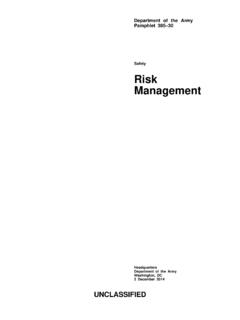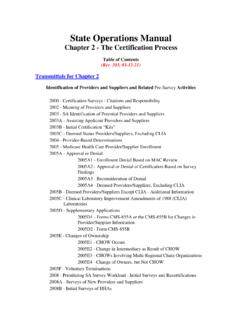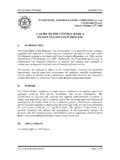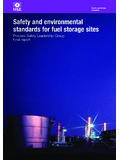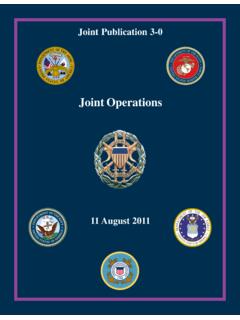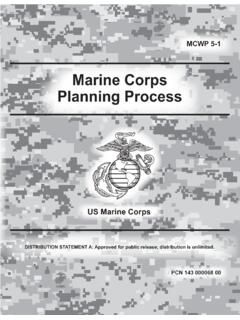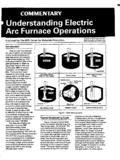Transcription of AC 91-70B - Oceanic and Remote Continental Airspace …
1 Department of Transportation Federal Aviation Administration Advisory Circular Subject: Oceanic and Remote Continental Airspace operations Date: 10/4/16 AC No: 91-70B Initiated by: AFS-400 Change: This advisory circular (AC) contains general information and detailed guidance for operators planning flights in Oceanic and Remote Continental Airspace , including authorizations needed for operations outside the Continental United States (CONUS). This includes Performance-based Navigation (PBN) and Special Areas of Operation (SAO). The Federal Aviation Administration (FAA) revised this AC to focus on the evolving operations in Airspace where air traffic control (ATC) provides procedural control. This AC is laid out in a chronological format, beginning with foundational information, followed by information on the training, authorizations, and equipment required to operate most efficiently in this Airspace , and finishing with flight planning, flight execution, and contingency operations guidance.
2 Our goal is to provide you with a template to guide you through planning and executing flight operations through Oceanic and Remote Continental Airspace . Information related to international operations in specific locales has been removed from this AC due to its transitory nature. Some region-specific information has been incorporated into the North Atlantic (NAT), West Atlantic Route System (WATRS)/Gulf of Mexico/Caribbean, and Pacific (PAC) Resource Guides (NAT PDF, West Atlantic, Caribbean, and Gulf of Mexico PDF, and PAC PDF). These online resource guides, along with the FAA Notices to Airmen (NOTAM) Domestic/International, provide the most current information available to pilots, aircraft dispatchers and other operational control personnel preparing for Oceanic and international operations . We have also included hyperlinks to many documents, available free or for purchase. The dynamics of Oceanic and Remote Continental Airspace operations are such that they are constantly evolving, and it is incumbent on you, the operators, to closely monitor any changes.
3 This AC neither is mandatory nor constitutes a regulation. When this AC uses mandatory language ( , must or may not ), it is quoting or paraphrasing a regulatory requirement or prohibition. When this AC uses permissive language ( , should or may ), it describes an acceptable means, but not the only means, of conducting that aspect of operations in Oceanic and international Airspace . However, if you use the means described in the AC, you must follow them in all important respects. John S. Duncan Director, Flight Standards Service 10/4/16 AC 91-70B iii CONTENTS Paragraph .. Page Chapter 1. General .. 1- 1 Purpose .. 1- 1 Cancellation .. 1- 1 Applicability .. 1- 1 Fundamental Changes from Previous Edition .. 1- 1 Traceability to the Code of Federal Regulations .. 1- 1 References (current editions) .. 1- 2 Chapter 2. Background Information for operations in Oceanic and Remote Continental Airspace .. 2- 1 The International Civil Aviation Organization (ICAO): Its Relationship to Aviation.
4 2- 1 ICAO Annexes .. 2- 1 Applicability of and International Regulations .. 2- 3 ICAO Guidance Documents and Reference Material .. 2- 4 Authorization to Operate in Special Areas of Operation (SAO) .. 2- 7 Authorization process Relative to SAO .. 2- 7 Web-Based operations Safety System (WebOPSS).. 2- 8 Chapter 3. Pilot Qualification and Training Guidance for International, Oceanic , and Remote Continental Airspace operations .. 3- 1 Operator/Pilot-in-Command (PIC) Responsibilities International operations .. 3- 1 Training Requirements for Oceanic and Remote Continental Airspace operations . 3- 1 Chapter 4. Communications, Navigation, and Surveillance Systems Guidance for operations in Oceanic and Remote Continental Airspace .. 4- 1 Communication, Navigation, and Surveillance Improvements Impact on Air Traffic 4- 1 Performance-Based operations .. 4- 1 Voice Communications in Oceanic and Remote Continental Airspace .. 4- 3 CPDLC and Automatic Dependent Surveillance-Contract (ADS-C).
5 4- 5 Data Link Systems Operational Authorization to Use .. 4- 6 ATC in Oceanic and Remote Continental Airspace .. 4- 6 Special Use Airspace (SUA) .. 4- 8 10/4/16 AC 91-70B iv Air Defense Identification Zones (ADIZ).. 4- 9 World Geodetic System 1984 (WGS 84).. 4- 9 Chapter 5. Flight Planning Guidance for International and Oceanic and Remote Continental Airspace operations .. 5- 1 Lead Time Requirements .. 5- 1 Preparing an Itinerary .. 5- 1 Crew Fatigue .. 5- 4 Required Paperwork/Documentation .. 5- 5 Entry to Foreign Airspace Flight Plan Versus Formal Advance 5- 7 Managing Risk in Oceanic and Remote Continental Airspace operations .. 5- 7 Weather Forecasts and Other Meteorological Planning .. 5- 8 Notices to Airmen (NOTAM) .. 5- 9 Extended operations (ETOPS) .. 5- 9 Polar 5- 10 Areas with Limited ATS .. 5- 10 Rotorcraft 5- 11 Chapter 6. Flight Execution Guidance for operations in Oceanic and Remote Continental Airspace .
6 6- 1 General Information .. 6- 1 Flight Plan .. 6- 4 Aircraft Preflight 6- 6 En Route Guidance .. 6- 11 Chapter 7. In-Flight Contingency Guidance for operations in Oceanic and Remote Continental Airspace .. 7- 1 Contingency Procedures: When They May Be Needed .. 7- 1 Choosing the Correct Contingency Procedure .. 7- 1 Altimetry and/or Navigation Degradation .. 7- 2 Lost Communications Procedures .. 7- 2 Appendix A. Abbreviations and Definitions .. A-1 Appendix B. Special Areas of Operation and OpSpecs/MSpecs/LOAs ..B-1 Appendix C. Unusual Weather Activity ..C-1 10/4/16 AC 91-70B v Appendix D. Sample Oceanic Checklist .. D-1 Appendix E. IATA In-Flight Broadcast Procedure .. E-1 Appendix F. Special Procedures for In- Flight Contingencies in Oceanic and Remote Continental Airspace .. F-1 Appendix G. Suggested Subjects for Inclusion in Oceanic and International Procedures and/or an operations Manual .. G-1 List of Figures Figure C-1. ICAO Volcanic Ash Advisory Centers.
7 C-1 Figure C-2. Example of a National Oceanic and Atmospheric Administration Scales Activity C-3 Figure E-1. Map of IFBP Area of Applicability .. E-4 Figure F-1. General Weather Deviation Procedures Model .. F-5 List of Tables Table 6-1. Examples of Incorrectly Applied Conditional Clearances .. 6-2 10/4/16 AC 91-70B 1-1 CHAPTER 1. GENERAL Purpose. The Federal Aviation Administration (FAA) ( we ) developed this advisory circular (AC) to provide general information and guidance for commercial and General Aviation (GA) operators ( you ) planning flights in Oceanic and Remote Continental Airspace . This guidance includes the authorizations you need for operations in such Airspace outside the Continental United States (CONUS). Cancellation. AC 91-70A, Oceanic and International operations , dated August 12, 2010, is canceled. AC 91-70, Oceanic operations , and the North Atlantic International General Aviation operations Manual (also known as the NAT IGA) are also obsolete.
8 Applicability. We have primarily targeted this AC at operators who do not yet have set procedures for flights through this type of Airspace and can use this AC as a guide in developing their own procedures. We are also targeting GA pilots who do not fly regularly in Oceanic and Remote Continental Airspace and need a refresher on what to consider before, during, and after such a flight. Most commercial operators have company procedures for operations in Oceanic and Remote Continental Airspace . Those procedures have been accepted by FAA inspectors and conform to all relevant regulations and guidance. If you are working for one of these operators, this AC may serve to reinforce your company procedures. Fundamental Changes from Previous Edition. Procedures for operating in Oceanic and Remote Continental Airspace are constantly evolving, and you should closely monitor any changes. We revised this AC to point you to the most current sources of international material. In some cases, we refer you to a Web site.
9 You can also find supplements to this material by starting at or by calling an FAA Special Areas of Operation (SAO) specialist. Contact information for your regional SAO specialist can be obtained from your local Flight Standards District Office (FSDO) or certificate management office (CMO). You may also be able to find this contact information on the North Atlantic (NAT), Pacific (PAC), and West Atlantic Route System (WATRS) Resource Guides. In this AC, we include specific guidance for authorizations and conformance with other FAA policy issues. Host nation Aeronautical Information Publications (AIP) and international Notices to Airmen (NOTAM) also contain the most recent information. Traceability to the Code of Federal Regulations. Refer to Title 14 of the Code of Federal Regulations (14 CFR): Part 91, through , through , through , through , , , through , , , , through , , , , , , through , , Appendix C, and Appendix G. Part 119, and Part 121, , , , , , , , and Appendix G.
10 10/4/16 AC 91-70B 1- 2 Part 125, , , , , , and Part 135, , , , , , , and Appendix G. References (current editions). RTCA Documents. 1. RTCA/DO-258/ED-100 (for purchase through RTCA), Interoperability Requirements for ATS Applications Using ARINC 622 Data Communications. 2. RTCA/DO-306/ED-122 (for purchase through RTCA), Safety and Performance Standard for Air Traffic Data Link Services in Oceanic and Remote Airspace ( Oceanic SPR Standard). FAA Technical Standard Orders (TSO). 1. TSO-C115, Flight Management System (FMS) Using Multi-Sensor Inputs. 2. TSO-C145, Airborne Navigation Sensors Using The Global Positioning System Augmented by the Satellite Based Augmentation System (SBAS). 3. TSO-C146, Stand-Alone Airborne Navigation Equipment Using The Global Positioning System Augmented by the Satellite Based Augmentation System (SBAS). 4. TSO-C196, Airborne Supplemental Navigation Sensors for Global Positioning System Equipment Using Aircraft-Based Augmentation.











